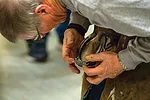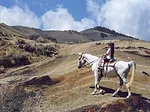Advertise Follow Us
American Farriers Journal

View Archived Issues
March 2015
Volume: 41
Edition: 2
American Farriers Journal is the “hands-on” magazine for professional farriers, equine veterinarians and horse care product and service buyers.
-
Table Of Contents
Table Of Contents
Summit Attendees Gobble Up the Whole Hoof-Care Package
Attendees take home 4 days of nonstop education for their practicesRead MoreHorse Owners Want More Footcare Details
Recent surveys reveal significant differences between what farriers believe clients are seeking in terms of information and what horse owners really wantRead MoreShoeing for a LivingBuilding His Own Style In Southern California
California farrier Tim Shannon says the knowledge he has gained from others has helped develop his footcare philosophyRead MoreTreating Hoof Infections With Maggots
Following a consultation with a veterinarian, this farrier uses maggot therapy for tough caseRead MoreQuantifying Functional Limb Length Disparity In Horses
This pilot study with five horses investigates a standardized method of calculating limb symmetry between pairs of forelimbsRead MoreSummit Mail-In Forging Exercise Winner Named
Stockport, Ohio, farrier Mike Augenstein wins inaugural forging exercise judged at the International Hoof-Care SummitRead MoreRemembering Bruce Daniels
Friends and colleagues recall how the Hall Of Fame farrier touched their livesRead MoreSteve Bloom
The renowned farrier and businessman will be remembered as a true gentleman and innovatorRead MoreIdentifying, Treating and Rehabbing Soft Tissue Injuries
Getting performance horses back on track after ligament and tendon injuriesRead MoreCryotherapy’s Role In Preventing And Managing Laminitis
Understand when, how and the duration of an ice slurry can benefit a horseRead MoreResearch Continues On Drug That Treats Laminitis Pain
University of California-Davis team nearing clinical trial of drug that targets severe pain of laminitisRead MoreRecognizing When X-Rays Are Legitimate Pictures
Veterinarian outlines three keys for helpful images in your farrier practice and how to get themRead MoreConsiderations for Getting a Better Fit
Farrier educator Dusty Franklin delivers insight on fitting feet by minding the basicsRead MoreGetting A Grip On Hammers
Tool experts give their advice on more comfortable usage of hammersRead MoreHelp Horse Owners Understand Climate Plays a Critical Role in Hoof Health
Ideal conditions can be created, even in less than ideal climatesRead MoreSix Honored For Outstanding Hoof-Care Careers
Three farriers and three veterinarians are inducted into Halls Of Fame for their life-long achievement in the footcare fieldRead MoreThree Farriers Recognized As Future Footcare Leaders
Three farriers were recognized at the 2015 International Hoof-Care Summit for making remarkable progress in their farrier careers just 3 years out of shoeing schoolRead MoreSpotlight on Hoof Care46th Annual Michigan Horseshoers Association Clinic Boasts Tough Competition
With four speakers and 3 days of competition, this historical event continues to offer learning opportunitiesRead More -
Featured Articles
Featured Articles
Treating Hoof Infections With Maggots
Following a consultation with a veterinarian, this farrier uses maggot therapy for tough caseRead MoreSummit Attendees Gobble Up the Whole Hoof-Care Package
Attendees take home 4 days of nonstop education for their practicesRead MoreShoeing for a LivingBuilding His Own Style In Southern California
California farrier Tim Shannon says the knowledge he has gained from others has helped develop his footcare philosophyRead More -
Online Extras
Online Extras

















